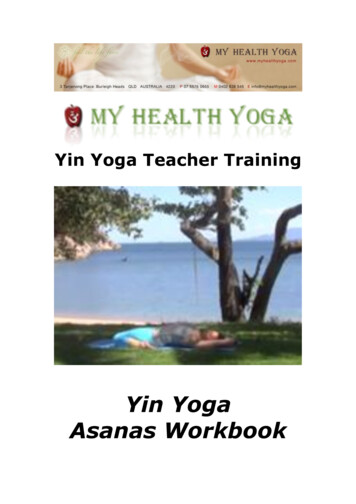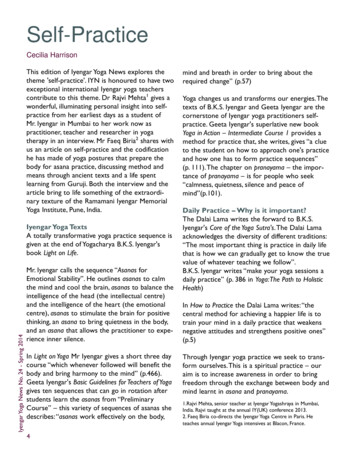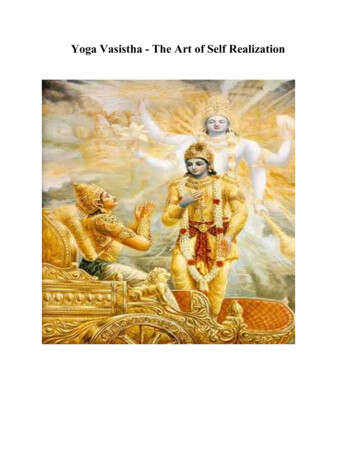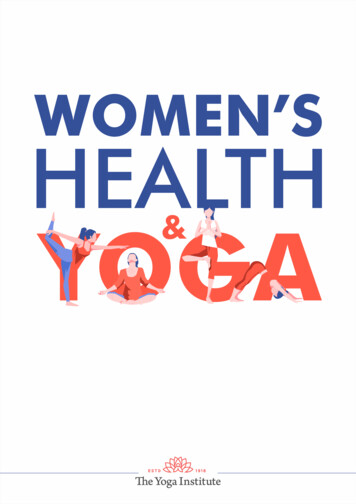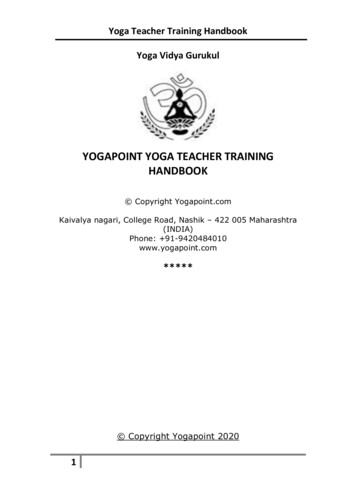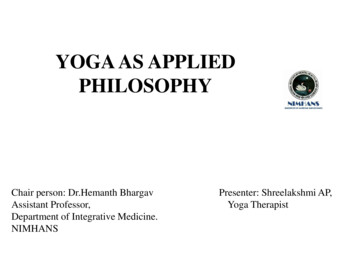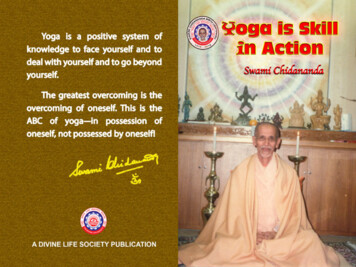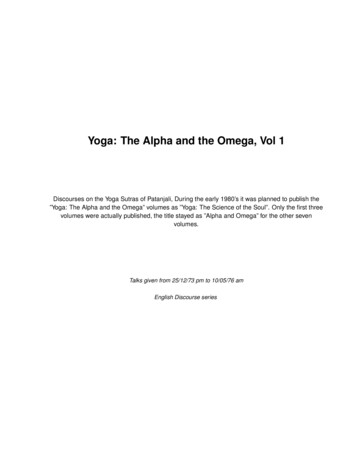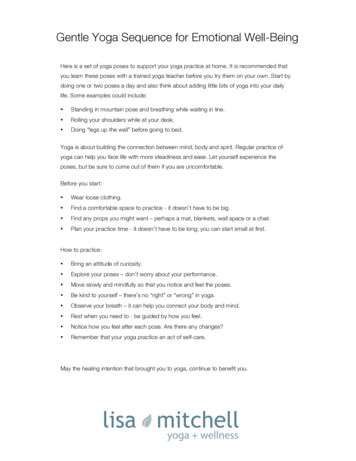
Transcription
Gentle Yoga Sequence for Emotional Well-BeingHere is a set of yoga poses to support your yoga practice at home. It is recommended thatyou learn these poses with a trained yoga teacher before you try them on your own. Start bydoing one or two poses a day and also think about adding little bits of yoga into your dailylife. Some examples could include: Standing in mountain pose and breathing while waiting in line. Rolling your shoulders while at your desk. Doing “legs up the wall” before going to bed.Yoga is about building the connection between mind, body and spirit. Regular practice ofyoga can help you face life with more steadiness and ease. Let yourself experience theposes, but be sure to come out of them if you are uncomfortable.Before you start: Wear loose clothing. Find a comfortable space to practice - it doesn’t have to be big. Find any props you might want – perhaps a mat, blankets, wall space or a chair. Plan your practice time - it doesn’t have to be long; you can start small at first.How to practice: Bring an attitude of curiosity. Explore your poses – don’t worry about your performance. Move slowly and mindfully so that you notice and feel the poses. Be kind to yourself – there’s no “right” or “wrong” in yoga. Observe your breath – it can help you connect your body and mind. Rest when you need to - be guided by how you feel. Notice how you feel after each pose. Are there any changes? Remember that your yoga practice an act of self-care.May the healing intention that brought you to yoga, continue to benefit you.
Sequence of Yoga PosesResting PoseHow To Little BoatHow To Table On hands and knees, inhale and gently arch your back(lifting chin and tailbone)As you exhale, round your spine like an angry cat and drawlower belly in and up.Slowly move back and forth between these two shapeswith breath.How To Come to hands and knees on the ground.Place hands under shoulders, and knees under hips.Press hands in to the floor.Feel arms firm.Notice your centre as you begin to gently hug in your lowerbelly.Perhaps shift your weight around.Sway hips side to side.How To Child’s PoseLie on back.Bend knees towards chest. Knees can be apart ortogether.Hands might rest on shins or knees.Explore rocking side to side if you wish.How To Cat/CowLie on back, knees bent with feet on floor.Perhaps place one hand on heart and one hand on belly.Breathe easily and naturally; feel the rise and fall of breathin your body.After some time, you may want to gently lengthen yourexhalation without straining; it might feel like a gentle sigh.You may wish to have an extra blanket to pad your knees.From hands and knees, shift hips back towards heels.Knees could be together or apart.You may bring arms forward in front of you or place themalongside your torso, or stack fists and rest your foreheadon top of fists.Try to rest your head on something.If you are stiff or have knee issues, place a folded blanketbetween hips and knees.Breathe naturally.Benefits Grounding andrelaxing.Promotesawareness ofbreath.Benefits Massages lowerback.Rocking may besoothing.Benefits Grounding.Builds support andstability.Benefits Wakes up thespine.Links movementand breath.Centering.Benefits Helps to lengthenyour spine.Grounding.May promote afeeling of rest andsafety.1
Mountain PoseHow To Shoulder RollsHow To Sun BreathsStand in mountain pose or sit in a chair.Place hands together in front of chest.On an inhalation, reach arms out to the sides.As you exhale, bring palms together in front of heart.Repeat a number of times.How To At your own pace, begin to make gentle circles with yourshoulders.Circles can be big or small.Reverse the direction of the circles.Breath is free and easy.How To Tree PoseCome up to a standing position.Place feet hip distance apart.Spread toes and press feet into ground.Firm the legs, hug lower belly in, feel length in your spine,relax shoulders, the skin on your face and jaw.Breathe in to stand taller and as you exhale, connect feet tothe earth.Eyes may be open or closed.Stand in mountain pose.You can stand beside a wall or use a chair to help withbalancing.Press left foot into ground and slowly bring the sole of theright foot to your left ankle.You can keep right toes on ground.Perhaps bring your palms together in front of your heart.Breathe naturally.You can stand beside a wall or use a chair to help withbalancing.Try balancing on the other leg.Benefits Grounding.Centering.Stabilizing.Promotes bodyawareness.Benefits Creates space.Encourages easeand mobilityaround shoulders.Benefits Creates space.Links movementand breath.Benefits Grounding.Stabilizing.Centering.Helps with focusand concentration.2
Standing Forward FoldHow To Bridge Modifications : 1) You can do the same pose using thewall for support behind your buttocks. 2) You can also do aseated forward fold on a chair. Caution : Be careful if you have a weak lower back.How To Little BoatFrom standing, take feet hip distant apart and slowly foldforward with your torso.You can keep the knees slightly bent and bend forward asmuch as you can.Perhaps bring forearms to thighs or you can let armsdangle with fingertips gently reaching towards floor.Let your head be heavy.Stay here for several breaths.To come out, on an inhalation slowly begin to roll up to astanding position.If you feel tension in lower back, support yourself by placinghands on your thighs as you make your way up.From standing, come to the ground and lie down.Bend knees and place feet on floor hip distance apart andparallel.Arms can be at your sides.Press down firmly with your feet to lift your hips.Breathe freely and easily for a few breaths and come downslowly.Rest and maybe repeat a few times.How To Lie on back.Bend knees towards chest. Knees can be apart ortogether.Hands might rest on shins or knees.Explore rocking side to side if you wish.Benefits Benefits How To Lie down with knees bent and feet on floor, a little widerthan hip distance apart, and arms reaching out to the sidelike wings.On an exhalation, gently take both knees over to the right.See if you can keep both shoulders on the ground.Pause here and breathe.Try taking the legs to the left side on an exhalation.Move back and forth a few times, exhaling knees to theside and inhaling knees back to the centre.Rest with legs back in the centre.Grounding.Strengthening.Lengthens thespine.Benefits Reclining TwistRestful for theheart.Can be relaxing forupper body.May be clearingand calming.Awareness of backbody.Releases andlengthens lowerback.Rocking may besoothing.Benefits Gentle twist of thespine that canbring freedom andease into the lowerback, pelvis andhips.3
Legs Up the Wallor on a ChairHow To Relaxation PoseIf choosing legs up the wall pose, you will need space on awall and one or two neatly folded blankets in a rectangularshape.Place one or two blankets about 6 inches away from thewall.Sit on one end of blanket(s), very close to wall with yourright side body up against the wall.Take both hands down to the ground and slide your leftarm and shoulder onto the ground as your roll onto yourback, positioning your pelvis on the blanket(s) and swingingyour legs up the wall - you might have to wiggle around alittle bit.Rest your legs, making yourself comfortable - this is arelaxation pose not a stretching pose.Settle into this pose for a few minutes and invite healing;consider staying for 5-10 minutes.To come out of pose, bend legs, slide feet down wall, andcarefully roll to one side; breath quietly for a few breathsand then use your arms to help you out. Modifications : 1) You can move blankets and your bodyfarther away from wall if you feel tightness in the back ofthe legs.2) Arms could be at your sides. 3) You could also have ablanket under your head. 4) You can also modify this poseby placing your legs on a chair seat or a couch; legs will bebent at the knees, and back of calves and feet will besupported by the chair. Caution : This pose is not recommended for people whoshould avoid inversions, people with hiatal hernias, eyepressure, retinal problems, or heart problems. You maywish to avoid this pose if you are menstruating.How To Lie on your back.Stretch your legs out on the floor or keep knees bent.Relax your arms at your sides, palms up or down.Be comfortable.Notice the support of the ground beneath your body.Perhaps you might want a blanket under your head or arolled blanket under your knees to relieve lower backtension.Let your body soften and let go.Take a few conscious breaths and stay for a few minutes.To come out of pose, bend your knees, roll slowly to oneside, and after a few breaths, push yourself up and noticehow you feel.Check in with yourself.Benefits Helps to reducefatigue and stress.Can quiet the mindand relieve tiredlegs.May help lowerblood pressurewith arms resting atsides of body.Benefits Grounding.Mind and body canquiet down.Helps soothe thenervous system.Namaste4
Gentle Yoga Sequence for Emotional Well-Being Here is a set of yoga poses to support your yoga practice at home. It is recommended that you learn these poses with a trained yoga teacher before you try them on your own. Start by doing one or two poses a day and also think about adding l


